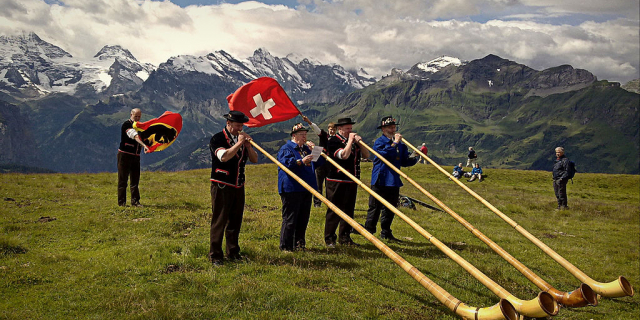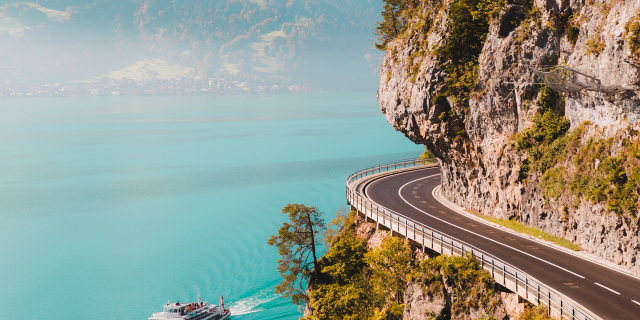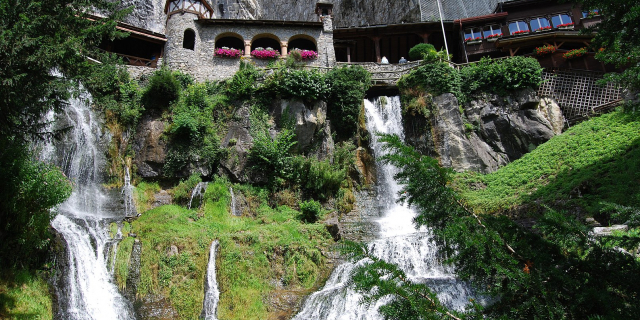A via ferrata (Italian for "iron path", plural vie ferrate or in English via ferratas) is a protected climbing route found in the Alps and certain other Alpine locations. The protection includes steel fixtures such as cables and railings to arrest the effect of any fall, which the climber can either hold onto or clip into using climbing protection. Some via ferrata can also include steel fixtures that provide aid in overcoming the obstacles encountered, including steel ladders and steel steps. The term "via ferrata" is use...Read more
A via ferrata (Italian for "iron path", plural vie ferrate or in English via ferratas) is a protected climbing route found in the Alps and certain other Alpine locations. The protection includes steel fixtures such as cables and railings to arrest the effect of any fall, which the climber can either hold onto or clip into using climbing protection. Some via ferrata can also include steel fixtures that provide aid in overcoming the obstacles encountered, including steel ladders and steel steps. The term "via ferrata" is used in most countries and languages except notably in German-speaking regions, which use Klettersteig—"climbing path" (plural Klettersteige).
Simple protected paths, with ladders and basic protection aids, have probably existed in the Alps for centuries, helping to connect villages to their high pastures. Construction of what could be seen as the precursors of modern via ferratas dates back to the growth of Alpine exploration and tourism in the nineteenth century. In 1843, a route on the Dachstein was constructed under the direction of Friedrich Simony; it included a range of climbing aids with iron pins, hand hooks, carved footholds, and ropes.[1] In 1869 a rope was fixed between the summits of Grossglockner, and in 1873 fixed protection was installed on the Zugspitze. In the Pyrenees, iron climbing aids were installed on the Pic du Midi d'Ossau in 1880, and in the Ordesa in 1881. The Northern Limestone Alps saw the first routes still in use today as via ferratas: the Heilbronner Way in the German Allgau Alps was constructed in 1899, shortly followed by the Eggersteig (1903) and Wildauersteig (1911) in the Wilder Kaiser in Austria.[2] In the Dolomites, the climbing path up the West ridge of the Marmolada (German: Marmolata) was installed in 1903, and the Possnecker Path up Piz Selva in the Sella Group was completed before the First World War.[3]
In 1910, Gustav Jahn and August Čepl, a Viennese master locksmith, built the Hans von Haid Steig in the Preiner Wall(1.783 m) of the Rax, East Austria.[4]
First World War: Dolomites Unexploded ordnance from World War I found during demining on Monte Piano in the Dolomites
Unexploded ordnance from World War I found during demining on Monte Piano in the DolomitesIn 1914 the Dolomites was part of the Austro-Hungarian Empire, which was part of the Central Powers during the First World War. In 1915, Italy joined the alliance of Britain, France, and Russia and declared war on the Central Powers. Austro-Hungarian troops were heavily committed in Russia and it immediately withdrew to a defensive line that ran through the Dolomites. The initially weak Austro-Hungarian troops were strongly supported by local old and very young men (Standschützen) who simulated a very strong line of defense for the attacking Italians. Only later could local elite troops such as Kaiserjäger and Kaiserschützen be relocated from the Eastern Front towards Italy. Until the Flitsch-Tolmein offensive (Battle of Caporetto) in the autumn of 1917, the Austro-Hungarians (supported by troops from Southern Germany) and the Italians fought a ferocious war in the mountains of the Dolomites; not only against each other but also against the hostile conditions. Both sides tried to gain control of the peaks to site observation posts and field guns. To help troops move about at high elevations in very difficult conditions, permanent lines were fixed to rock faces and ladders were installed so that troops could ascend steep faces.[5] They also tried to create and control tunnels below the peaks to attack from there (see Mines on the Italian Front). Trenches, dugouts, and other relics of the First World War can be found alongside many via ferratas. Since dangerous ammunition remains and the like can still be found today, warnings are given in the area of the former main battle line against digging and picking up old metal parts. There is an extensive open-air museum on 5 Torri, and around Lagazuoi, where very heavy fighting took place. This wartime network of via ferratas has been restored, although not until well after the Second World War: steel cables have replaced ropes, and iron ladders and metal rungs anchored into the rock have taken the place of the flimsy wooden structures used by the troops. Most of these routes are now maintained by the Club Alpino Italiano (CAI; Italian Alpine Club) and the South Tyrol Alpine Club (AVS).
 Wire bridge "Seufzerbrücke" at Postalmklamm Klettersteig near Salzburg, AustriaVia delle Bocchette: the classic via ferrata
Wire bridge "Seufzerbrücke" at Postalmklamm Klettersteig near Salzburg, AustriaVia delle Bocchette: the classic via ferrata
In the 1930s, the Società degli Alpinisti Tridentini (SAT) together with the CAI began working on shortening and improving access to the climbing routes in the Brenta Dolomites, by installing artificial aids and protection. Natural lines and routes in the rock were linked up and a system of routes began to be developed, work continuing after the Second World War. The Via delle Bocchette was discovered by mountain walkers and gradually gained a classic reputation in its own right, a reputation which it still retains.[6] In developing the Via delle Bocchette, a certain ethic was followed – climbing aids were kept to a minimum, and the routes deliberately do not access any summits, an approach which is sometimes but not always followed by modern via ferratas. The Via delle Bocchette helped establish the idea of doing via ferratas in their own right, rather than as access to summits or to climbs.[3]
21st centuryIn the 1970s and 80s development remained focused on traditional areas (the Dolomites and the Northern Limestone Alps). Routes were mostly developed by the climbing community often with the active involvement of one of the relevant Alpine Clubs (although there was occasional controversy and opposition to some added routes).[citation needed] In the 1990s and 2000s, development became more commercial and involved more organizations: via ferratas began to be seen as a useful way to encourage tourism and increase the range of activities available to visitors, and so routes were developed by local communities, outdoor activity centres, cable car companies, mountain refuges and others, as well as continuing involvement by the Alpine clubs.[7] Development of via ferratas has spread out of its original areas to the rest of the Alps and beyond. The first via ferrata in France was constructed in 1988 (Via Ferrata de la Grande Falaise, Freissinières, Grading C/D)[7] While high mountain via ferratas have continued to be developed, the modern era has seen the rise of more "sporting" routes, sometimes closer to the valley and often more challenging in nature, with severely steep sections and requiring high strength. Routes have been built in dramatic locations, alongside waterfalls or in canyons. Other routes include features such as wire bridges and even zip wires, designed to increase their appeal to visitors. Climbing via ferratas came to be recognised as a valid mountain activity in own right, with its own guidebooks, equipment, grading system and enthusiasts, with an increasing number of locations becoming available to undertake via ferrata climbs.


































Add new comment